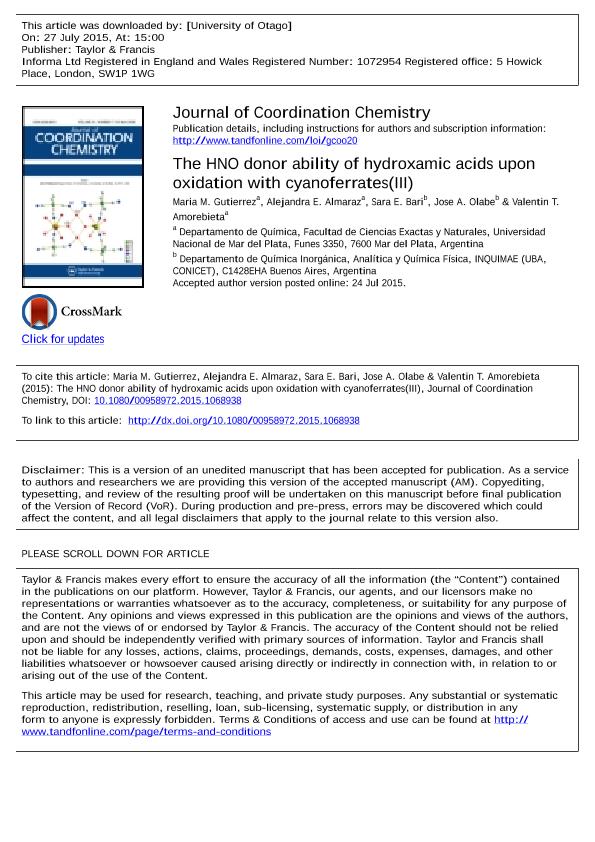Artículo
The HNO donor ability of hydroxamic acids upon oxidation with cyanoferrates(III)
Gutierrez, Maria Marta; Almaraz, Alejandra E.; Bari, Sara Elizabeth ; Olabe Iparraguirre, Jose Antonio
; Olabe Iparraguirre, Jose Antonio ; Amorebieta, Valentín Tomás
; Amorebieta, Valentín Tomás
 ; Olabe Iparraguirre, Jose Antonio
; Olabe Iparraguirre, Jose Antonio ; Amorebieta, Valentín Tomás
; Amorebieta, Valentín Tomás
Fecha de publicación:
09/2015
Editorial:
Taylor & Francis Ltd
Revista:
Journal of Coordination Chemistry
ISSN:
0095-8972
Idioma:
Inglés
Tipo de recurso:
Artículo publicado
Clasificación temática:
Resumen
The hydroxamic acids (RC(O)NHOH, HA) exhibit diverse biological activity, including hypotensive properties associated with formation of nitroxyl (HNO) or nitric oxide (NO). Oxidation of two HAs, benzohydroxamic and acetohydroxamic acids (BHA, AHA) by [Fe(CN)5NH3]2- or [Fe(CN)6]3- was analyzed by spectroscopic, mass spectrometric techniques, and flow EPR measurements. Mixing BHA with both Fe(III) reactants at pH 11 allowed detecting the hydroxamate radical, (C6H5)C(O)NO-, as a one-electron oxidation product, as well as N2O as a final product. Successive UV-vis spectra of mixtures containing [Fe(CN)5NH3]2- (though not [Fe(CN)6]3-) at pH 11 and 7 revealed an intermediate acylnitroso-complex, [Fe(CN)5NOC(O)(C6H5)]3- (max, 465 nm, very stable at pH 7), formed through ligand interchange in the initially formed reduction product, [Fe(CN)5NH3]3-, and characterized by FTIR spectra through the stretching vibrations (CN), (CO), and (NO). Free acylnitroso derivatives, formed by alternative reaction paths of the hydroxamate radicals, hydrolyze forming RC(O)OH and HNO, postulated as precursor of N2O. Minor quantities of NO are formed only with an excess of oxidant. The intermediacy of HNO was confirmed through its identification as [Fe(CN)5(HNO)]3- (max, 445 nm) as a result of hydrolysis of [Fe(CN)5(NOC(O)(C6H5)]3- at pH 11. The results demonstrate that hydroxamic acids behave predominantly as HNO donors.
Archivos asociados
Licencia
Identificadores
Colecciones
Articulos(INQUIMAE)
Articulos de INST.D/QUIM FIS D/L MATERIALES MEDIOAMB Y ENERGIA
Articulos de INST.D/QUIM FIS D/L MATERIALES MEDIOAMB Y ENERGIA
Citación
Gutierrez, Maria Marta; Almaraz, Alejandra E.; Bari, Sara Elizabeth; Olabe Iparraguirre, Jose Antonio; Amorebieta, Valentín Tomás; The HNO donor ability of hydroxamic acids upon oxidation with cyanoferrates(III); Taylor & Francis Ltd; Journal of Coordination Chemistry; 68; 17-18; 9-2015; 3236-3246
Compartir
Altmétricas



